
Electric Lab Press
Laboratory Hydraulic Pellet Press for XRF KBR FTIR Lab Applications
Item Number : PCPE
Price varies based on specs and customizations
- Working pressure
- 0-60 T
- Piston diameter
- 95-150 mm
- Piston stroke
- 30-50 mm
- Gauge range
- 0-40 Mpa
Shipping:
Contact us to get shipping details Enjoy On-time Dispatch Guarantee.
Why Choose Us
Reliable PartnerEasy ordering process, quality products, and dedicated support for your business success.
Applications
Hydraulic press is widely used in material researching labs,pharmacy,catalytic reaction,ceramics, electronic industries, it is one high efficient equipment for the sample preparing, due to its small footprint, it easy to carry and move, can work inside the vacuum glove box for processing under vacuum environment. Hydraulic press can also process hot press function with heating plates, which can serve the particular material processing
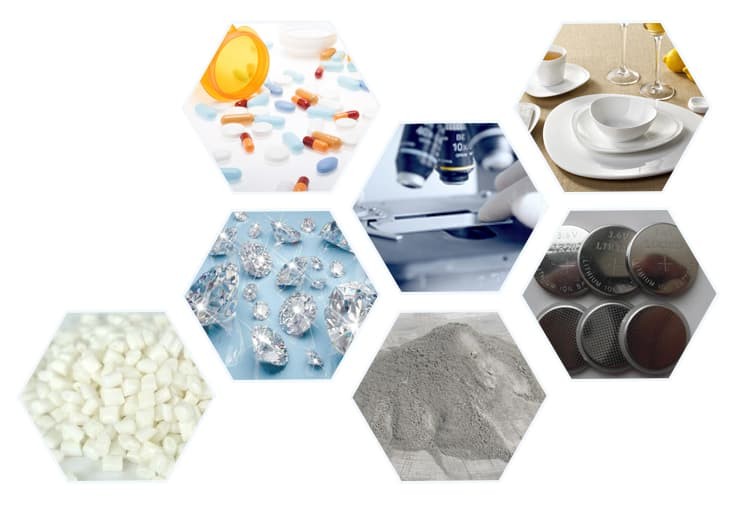
Feature
- Small footprint, light weight, easy to carry and move, nice fitting vacuum glove box
- Both electric driving and manual press are available, high precision digital pressure gauge
- Pressure can be programmed, hydraulic will restart working when pressure drops to set value
- 12-24T model machine output sample can meet requirement of infrared spectrometer
- 24-40T model machine output sample can meet requirement of fluorescence spectrometer
Detail & Parts



- Flexible: The tablet press has two modes: manual pressurization and electric pressurization. The operation is more flexible, and the manual pressurization pressure can be controlled more accurately.
- Control: When the pressure is lower than the pressure control line, the equipment will automatically turn on to compensate for pressure, which can achieve a long-term automatic pressure maintaining function.
- Accuracy: The electric tablet press uses a digital pressure controller, and the digital display of pressure is more accurate than the pressure display of the pointer pressure gauge.
Operation interface

- Parameter setting: Click parameter setting to enter the setting menu.
- Pressure setting: You can set the applied pressure.
- Set time: You can set the pressurization timer. When the pressure holding time is up, the device will remind you to release the pressure.
- Sample size: You can set the shape and size of the sample. The device will automatically calculate the pressure of the sample according to the size you set to avoid overpressure.
- Start button: Click the start button and the device starts to run according to the set parameters. When the pressure is reached, it will automatically stop pressurization and start to automatically replenish pressure. The button "Start" becomes "Stop".
- Stop button: Click the stop button and the device exits the pressure holding program. Then send the oil release valve stem to release the pressure.
Advantages
- The upper plate adopts electroplated countersunk head hexagonal screws, beautiful and space-saving
- Chrome-plated cylinder, smooth surface, no rust, good sealing rubber ring, no oil leakage
- One-piece main board structure, oil pool, main board, oil cylinder in a body, no seal connection
- Extended pulling spring, good rebound effect, not easy to deformation, can achieve the cylinder 30mm return without deformation
- All aluminum alloy hand wheel, beautiful, practical, not easy to break
- Small size, light weight, no oil leakage, can be used in the glove box
- Mold using Japanese high-speed steel, good material, high hardness, no deformation, long service life
- Digital display pressure gauge, more accurate pressure control, pressure display accuracy of 0.01MPa
- Oil pool outside the host, easy to replace the oil, and the oil circuit increased the hydraulic oil filtration device
- Special plunger, using special custom sealing structure, excellent sealing effect
- Pressurizing device, placed in the lowermost corner of the mainframe, the angle is reasonable, pressurizing force does not tilt back
Technical specifications
| Instrument model | PCPE-20T | PCPE-30T | PCPE-40T | PCPE-60T |
|---|---|---|---|---|
| Pressure range | 0-20T(0-28MPa) | 0-30T(0-31.5MPa) | 0-40T(0-30MPa) | 0-60T(0-33MPa) |
| Piston diameter | Φ95mm (d) | Φ110mm (d) | Φ130mm (d) | Φ150mm (d) |
| Integral structure | No sealing connection, oil leakage reduced | No sealing connection, oil leakage reduced | No sealing connection, oil leakage reduced | No sealing connection, oil leakage reduced |
| Pressure gauge | Digital display 0.00-40.00 MPa | Digital display 0.00-40.00 MPa | Digital display 0.00-40.00 MPa | Digital display 0.00-40.00 MPa |
| Maximum pressure (T) | 30mm | 40mm | 50mm | 50mm |
| Pressure stability | ≤1MPa/10min | ≤1MPa/10min | ≤1MPa/10min | ≤1MPa/10min |
| Pressurization mode | Electric / manual | Electric / manual | Electric / manual | Electric / manual |
| Compensation mode | Auto/ manual | Auto/ manual | Auto/ manual | Auto/ manual |
| Workbench diameter | Φ105mm (D) | Φ120mm (D) | Φ140mm(D) | Φ160mm (D) |
| Number of columns | Four | Four | Four | Four |
| Working space | 80×150mm(M×N) | 92×160mm(M×N) | 115×185mm(M×N) | 185×250mm(M×N) |
| Dimensions | 245×415×415mm(L×W×H) | 275×430×420mm(L×W×H) | 295×450×500mm(L×W×H) | 405×470×565mm(L×W×H) |
| Power supply | 220V(50Hz/60Hz) | 220V(50Hz/60Hz) | 220V(50Hz/60Hz) | 220V(50Hz/60Hz) |
| Weight | 58Kg | 72Kg | 92Kg | 140Kg |
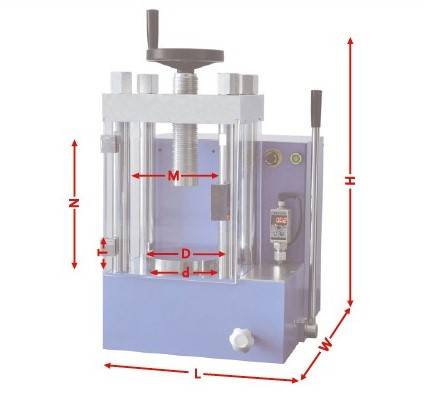
| Force | Pressure |
|---|---|
| 1 [Tons] | 1.41 [MPa] |
| 2 [Tons] | 2.82 [MPa] |
| 3 [Tons] | 4.23 [MPa] |
| 5 [Tons] | 7.06 [MPa] |
| 8 [Tons] | 11.3 [MPa] |
| 10 [Tons] | 14.1 [MPa] |
| 12 [Tons] | 17 [MPa] |
| 15 [Tons] | 22.6 [MPa] |
| 20 [Tons] | 28 [MPa] |
| Note: The system pressure intensity shouldn't exceed 35 MPa, or else it will shorten the service life of the equipment. | |

Operating steps
How to replace accessories and precautions
Before we get started, please make sure you have read the manufacturer's instructions carefully and are familiar with the basic components of the machine. Once you are comfortable with the machine, follow these steps to operate it:

1.Place the sample in the mold.

2.Place the mold in the tablet press.

3.Set the required pressure.

4.Click the press button to start pressurization.

5.Stop pressurization and remove the mold.

6. Remove the pressed sample.
Full range of lab press types
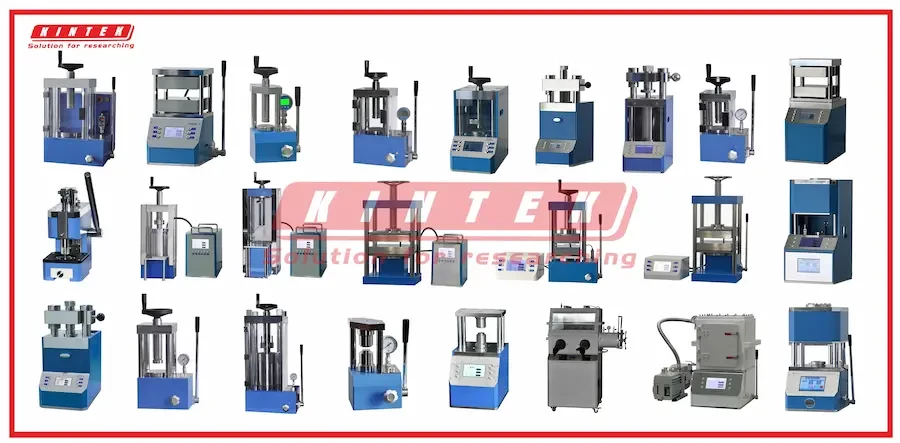
Click to view our full range of lab press products.
Any question? Our experts have helped many laboratories choose their lab press, contact us now!
Full range of types of laboratory press molds
We have a full range of molds for you to choose from, and the molds fit the body perfectly.
If you need molds with special shapes, we can also customize them for you.
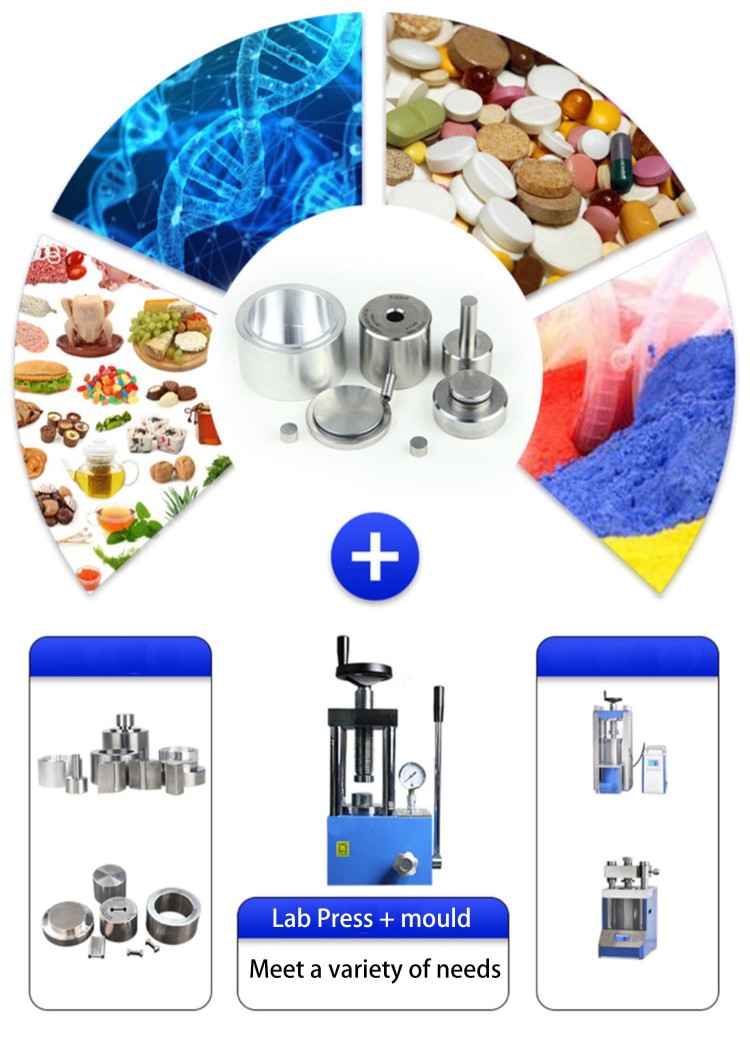
Warnings
Operator safety is the top important issue! Please operate the equipment with cautions. Working with inflammable& explosive or toxic gases is very dangerous, operators must take all necessary precautions before starting the equipment. Working with positive pressure inside the reactors or chambers is dangerous, operator must fellow the safety procedures strictly. Extra caution must also be taken when operating with air-reactive materials, especially under vacuum. A leak can draw air into the apparatus and cause a violent reaction to occur.
Designed for You
KinTek provide deep custom made service and equipment to worldwide customers, our specialized teamwork and rich experienced engineers are capable to undertake the custom tailoring hardware and software equipment requirements, and help our customer to build up the exclusive and personalized equipment and solution!
Would you please drop your ideas to us, our engineers are ready for you now!
FAQ
What Is An FTIR Press Used For?
What Is A Lab Press?
What Types Of FTIR Presses Are Available?
What Is The Purpose Of A Hydraulic Press In Lab?
How Does An FTIR Press Work?
What Are Different Type Of Lab Presses?
What Are The Advantages Of Using An FTIR Press?
What Materials Can Be Used With An FTIR Press?
4.9
out of
5
As a lab manager, I can attest to the accuracy and consistency of this press. It has significantly improved our workflow.
4.7
out of
5
The automated features of this press have freed up our technicians to focus on other tasks, leading to increased productivity.
4.8
out of
5
The integrated pellet dies and swift operations make this press an excellent choice for high-throughput sample preparation.
4.6
out of
5
The ease of use and minimal lab space required make this press a valuable asset to our laboratory.
4.7
out of
5
The ability to produce firm pellets from various powdered materials without adding a binder is a significant advantage.
4.9
out of
5
The high-throughput production of pellets for XRF analysis makes this press an essential tool for our laboratory.
4.8
out of
5
The small footprint, light weight, and easy portability of this press make it ideal for use in our mobile laboratory.
4.7
out of
5
The accuracy of the digital pressure controller and the long-term automatic pressure maintaining function ensure consistent and reliable results.
4.9
out of
5
The extended pulling spring and chrome-plated cylinder ensure smooth operation and minimal maintenance.
4.6
out of
5
The ability to pressurize manually or electrically provides flexibility and control during the pressing process.
REQUEST A QUOTE
Our professional team will reply to you within one business day. Please feel free to contact us!
Related Products

Automatic Laboratory Hydraulic Press for XRF & KBR Pellet Press
Fast and easy xrf sample pellet preparation with KinTek Automatic Lab Pellet Press. Versatile and accurate results for X-ray fluorescence analysis.

Laboratory Manual Hydraulic Pellet Press for Lab Use
Efficient sample preparation with small footprint Manual Lab Hydraulic Press. Ideal for material researching labs, pharmacy, catalytic reaction, and ceramics.

Introducing the KINTEK KBR Press - a handheld laboratory hydraulic press designed for entry-level users.

Automatic Laboratory Hydraulic Pellet Press Machine for Lab Use
Experience efficient sample preparation with our Automatic Lab Press Machine. Ideal for material research, pharmacy, ceramics, and more. Features a compact size and hydraulic press functionality with heating plates. Available in various sizes.

Laboratory Manual Hydraulic Pellet Press for Lab Use
Efficient Manure Lab Hydraulic Press with Safety Cover for sample preparation in material research, pharmacy, and electronic industries. Available in 15T to 60T.

Laboratory Hydraulic Press Lab Pellet Press Machine for Glove Box
Controlled environment lab press machine for glove box. Specialized equipment for material pressing and shaping with high precision digital pressure gauge.

Laboratory Hydraulic Press Lab Pellet Press for Button Battery
Efficiently prepare samples with our 2T Button Battery Press. Ideal for material research labs and small-scale production. Small footprint, lightweight, and vacuum-compatible.

Laboratory Hydraulic Press Split Electric Lab Pellet Press
Efficiently prepare samples with a split electric lab press - available in various sizes and ideal for material research, pharmacy, and ceramics. Enjoy greater versatility and higher pressure with this portable and programmable option.
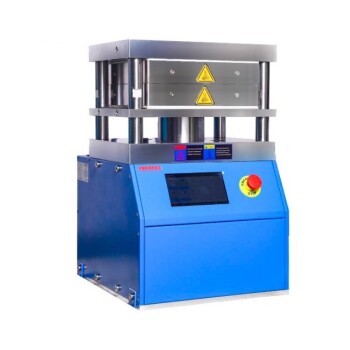
Automatic Heated Hydraulic Press Machine with Heated Plates for Laboratory Hot Press 25T 30T 50T
Efficiently prepare your samples with our Automatic Heated Lab Press. With a pressure range up to 50T and precise control, it's perfect for various industries.

Heated Hydraulic Press Machine with Integrated Manual Heated Plates for Lab Use
Efficiently process heat-pressing samples with our Integrated Manual Heated Lab Press. With a heating range up to 500°C, it's perfect for various industries.

Heated Hydraulic Press Machine with Heated Plates Split Manual Laboratory Hot Press
Efficiently prepare your samples with our Split Manual Heated Lab Press. With a pressure range up to 40T and heating plates up to 300°C, it's perfect for various industries.

Electric Heated Hydraulic Vacuum Heat Press for Lab
The Electric Vacuum Heat Press is a specialized heat press equipment that operates in a vacuum environment, utilizing advanced infrared heating and precise temperature control for high quality, rugged and reliable performance.

Automatic Heated Hydraulic Press Machine with Heated Plates for Laboratory Hot Press
The Automatic High Temperature Heat Press is a sophisticated hydraulic hot press designed for efficient temperature control and product quality processing.

Heated Hydraulic Press Machine with Heated Plates for Vacuum Box Laboratory Hot Press
Enhance your lab's precision with our lab press for vacuum box. Press pills and powders with ease and precision in a vacuum environment, reducing oxidation and improving consistency. Compact and easy to use with a digital pressure gauge.

Manual Heated Hydraulic Press Machine with Heated Plates for Laboratory Hot Press
The Manual Heat Press is a versatile piece of equipment suitable for a variety of applications, operated by a manual hydraulic system that applies controlled pressure and heat to the material placed on the piston.

Heated Hydraulic Press Machine with Heated Plates for Vacuum Box Laboratory Hot Press
The lab press for vacuum box is a specialized piece of equipment designed for laboratory use. Its main purpose is to press pills and powders according to specific requirements.
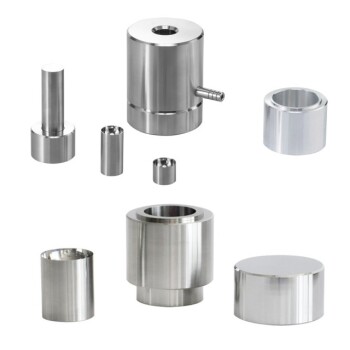
Explore versatile Hydraulic Hot Press molds for precise compression molding. Ideal for creating various shapes and sizes with uniform stability.
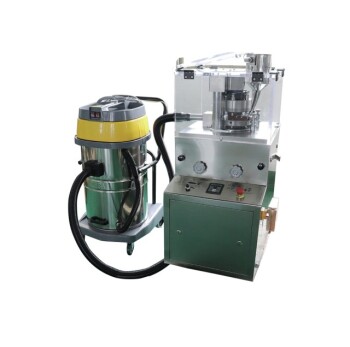
Lab Scale Rotary Single Punch Tablet Press Machine TDP Tablet Punching Machine
This machine is a single-pressure automatic rotating, continuous tableting machine that compresses granular raw materials into various tablets. It is mainly used for tablet production in the pharmaceutical industry, and is also suitable for chemical, food, electronics and other industrial sectors.
Related Articles

A Comprehensive Guide on Pressing XRF Pellets Using a KinTek Automatic Hydraulic Press
XRF (X-ray fluorescence) analysis is a powerful technique used in various industries for material analysis. One crucial step in the XRF analysis process is the preparation of high-quality XRF pellets. These pellets serve as the sample for analysis and need to be properly pressed to ensure accurate results.

Operating of Automatic Lab xrf Pellet Press
How to use the Automatic Lab xrf Pellet Press, including steel ring, plastic ring, boric acid mold

Manual Hydraulic Pellet Press: An Efficient Tool for Spectral Analyses Preparation
The manual hydraulic pellet press offers several key features that make it a valuable tool for laboratory applications. Some of the main features include:Availability of pressing tools in different diameters: 40mm, 32mm, and 15mm;Availability of pressing tools in different diameters: 40mm, 32mm, and 15mm;Designed pressure force display in 10 kN steps;Ease of operation via hand lever;Convenience in cleaning;Single-stage piston stroke of maximum 25mm ect.

Automated laboratory XRF and KBR pellet press operating procedures
Introduction to automated laboratory XRF and KBR pellet press operating procedures.

Understanding Hydraulic Pellet Press: Working Mechanism and Applications
A hydraulic press, also known as a Bramah press, is a machine that uses fluid pressure to generate a force. This force can be used to compress or mold materials. Hydraulic presses are commonly used in manufacturing and industrial applications due to their ability to exert a large amount of force while still being easy to operate.

Comprehensive Guide to Manual Hydraulic Pellet Press
A manual hydraulic pellet press is a valuable tool in the laboratory for preparing pellets with a smooth and homogeneous surface for spectral analyses. It is commonly used in applications such as X-ray fluorescence analysis or infrared spectroscopy for elemental analysis.

The Benchtop KBr Pellet Press: An Efficient Tool for Laboratory Use
The benchtop KBr pellet press is a versatile and efficient tool that produces uniform pellets, ensuring consistent and reliable results. In addition, its adjustable mold can be used flexibly to accommodate a variety of sample sizes and shapes.

Guide for Xrf Pellet Press
An XRF tablet press is a machine used to prepare samples for X-ray fluorescence (XRF) analysis by pressing them into a uniform tablet or pellet form.

Automatic Hydraulic Press: The Ultimate Guide for Efficient Sample Preparation and Industrial Processes
Discover the world of automatic hydraulic presses, from their versatile applications in industrial XRF and laboratory sample manipulation to their role in large-scale manufacturing, hot embossing, laminating, and polymer melting. Learn about their benefits, features, and how they revolutionize sample preparation and industrial processes.

Understanding the Functioning and Applications of a Hydraulic Pellet Press
A hydraulic press is a compression device that makes use of an exerted force placed upon a fluid, to create a resulting force according to Pascal’s Law. It was actually invented by Joseph Bramah, so is also known as the Bramah Press.

An In-Depth Guide on Laboratory Presses and KBr Pellets Production
In the world of scientific research and analysis, laboratory presses and KBr pellet production play a crucial role. These tools are essential in the preparation of samples for various analytical techniques, such as infrared spectroscopy and XRF spectroscopy.

Choosing the Right Lab Press: A Comprehensive Guide
When choosing a lab press, it is important to consider the load or force that will be applied to the sample. This will ensure that the press is capable of providing the necessary pressure for your specific application.